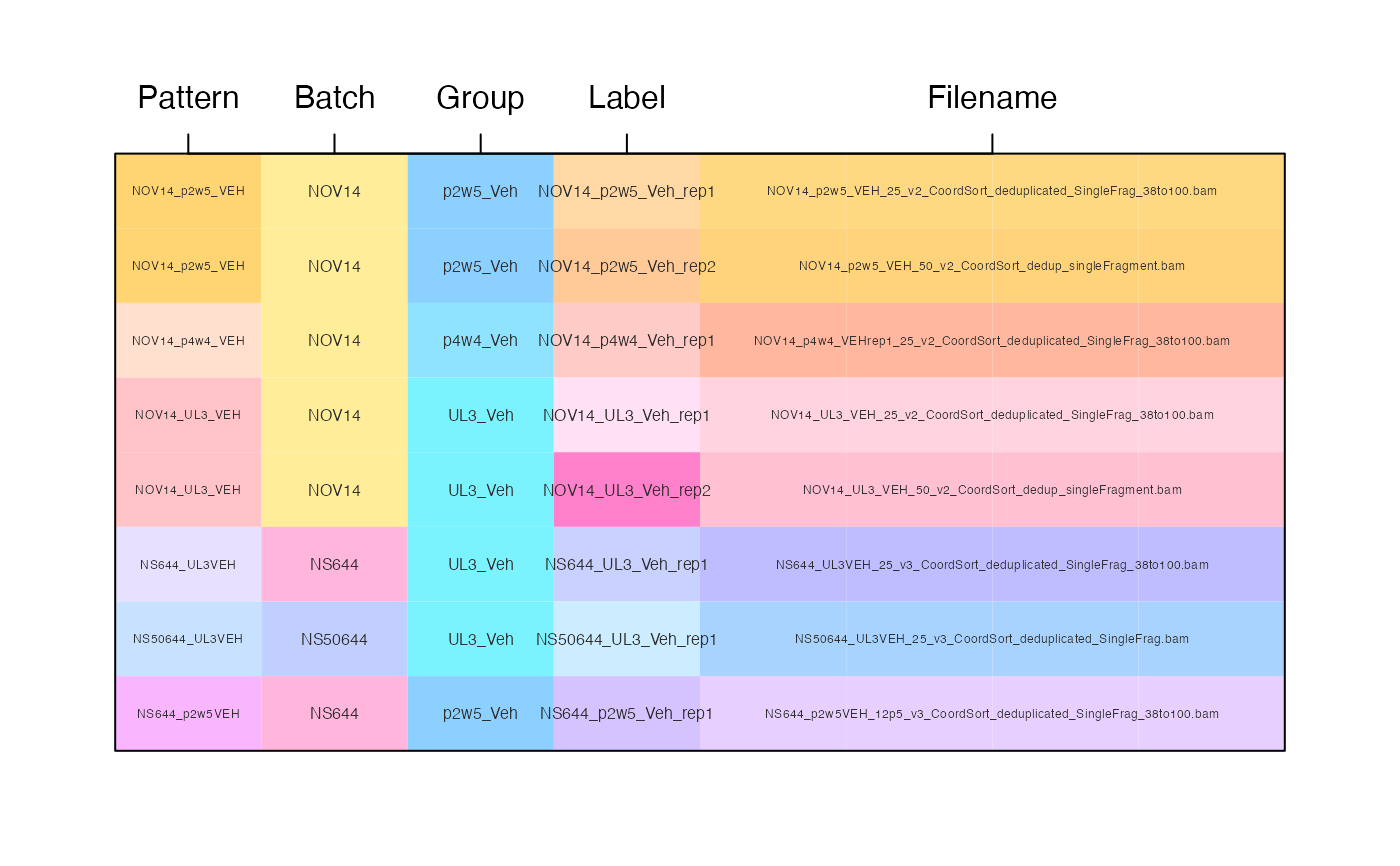Curate vector to data.frame by pattern matching
Source:R/jam-curate-to-df.R
curate_to_df_by_pattern.RdCurate vector to data.frame by pattern matching
Arguments
- x
charactervector of input data, often filenames used when importing data using one of theimport_*functions.- df
data.framewhose first column containscharacterpatterns, and subsequent columns contain annotations to be applied to entries inxthat match a given pattern. The column that contains patterns can be specified with argumentpattern_colname.- pattern_colname, group_colname, id_colname
characterstring indicating colname to use for patterns, group, and identifier, respectively. Thegroup_colnameandid_colnamemay beNULLin which case they are not used. Whengroup_colnameandid_colnameare defined, then values ingroup_colnameare used to make unique identifiers for each entry inx, and are stored inid_colname.- input_colname
characterstring indicating the colname to use for the input data supplied byx. For example wheninput_colname="filename"then values inxare stored in a column"filename".- suffix, renameOnes
arguments passed to
jamba::makeNames(), used whengroup_colnameandid_colnameare defined,jamba::makeNames(df[[group_colname]], suffix, renameOnes)is used to make unique names for each row.- colname_hook
functioncalled on colnames, for examplejamba::ucfirst()applies upper-case to the first character in each colname. Whencolname_hook=NULLthen no changes are made.- sep
characterstring passed tojamba::pasteByRow()when concatenating columns to create a unique identifier for each row.- order_priority
characterstring indicating how the outputdata.framerow order should be defined. Note that the output will only include entries inxthat were found in the curationdf."df": output follows the order of matching rows indf"x": output follows the order of matchingxvalues
- ...
additional arguments are passed to
jamba::makeNames().
Value
data.frame with number of rows equal to the length of input,
length(x). Columns are defined by the input colnames(df).
Note that the row order of the output will match the
curation df input.
The purpose of sorting by curation df is so this data can define
the order of factors used in downstream statistical contrasts.
The factor order is used to define the control group, as
the first factor is preferentially the control group.
Details
This function takes a character vector, and converts it into
a data.frame using pattern matching defined in the corresponding
df argument data.frame. The first column of df contains
character string patterns. Whenever a pattern matches
the input vector x, the annotations for the corresponding row in
df are applied to that entry in x.
See also
Other jam utility functions:
cardinality(),
color_complement(),
convert_PD_df_to_SE(),
convert_imputed_assays_to_na(),
curate_se_colData(),
design2layout(),
get_numeric_transform(),
handle_df_args(),
merge_proteomics_se(),
rowNormScale()
Examples
df <- data.frame(
pattern=c("NOV14_p2w5_VEH",
"NOV14_p4w4_VEH",
"NOV14_UL3_VEH",
"NS644_UL3VEH",
"NS50644_UL3VEH",
"NS644_p2w5VEH"),
batch=c("NOV14",
"NOV14",
"NOV14",
"NS644",
"NS50644",
"NS644"),
group=c("p2w5_Veh",
"p4w4_Veh",
"UL3_Veh",
"UL3_Veh",
"UL3_Veh",
"p2w5_Veh")
);
## review the input table format
print(df);
#> pattern batch group
#> 1 NOV14_p2w5_VEH NOV14 p2w5_Veh
#> 2 NOV14_p4w4_VEH NOV14 p4w4_Veh
#> 3 NOV14_UL3_VEH NOV14 UL3_Veh
#> 4 NS644_UL3VEH NS644 UL3_Veh
#> 5 NS50644_UL3VEH NS50644 UL3_Veh
#> 6 NS644_p2w5VEH NS644 p2w5_Veh
x <- c("NOV14_p2w5_VEH_25_v2_CoordSort_deduplicated_SingleFrag_38to100.bam",
"NOV14_p4w4_VEHrep1_25_v2_CoordSort_deduplicated_SingleFrag_38to100.bam",
"NOV14_UL3_VEH_25_v2_CoordSort_deduplicated_SingleFrag_38to100.bam",
"NS644_UL3VEH_25_v3_CoordSort_deduplicated_SingleFrag_38to100.bam",
"NOV14_p2w5_VEH_50_v2_CoordSort_dedup_singleFragment.bam",
"NOV14_UL3_VEH_50_v2_CoordSort_dedup_singleFragment.bam",
"NS50644_UL3VEH_25_v3_CoordSort_deduplicated_SingleFrag.bam",
"NS644_p2w5VEH_12p5_v3_CoordSort_deduplicated_SingleFrag_38to100.bam")
df_new <- curate_to_df_by_pattern(x, df);
## Review the curated output
print(df_new);
#> Pattern Batch Group Label
#> NOV14_p2w5_Veh_rep1 NOV14_p2w5_VEH NOV14 p2w5_Veh NOV14_p2w5_Veh_rep1
#> NOV14_p2w5_Veh_rep2 NOV14_p2w5_VEH NOV14 p2w5_Veh NOV14_p2w5_Veh_rep2
#> NOV14_p4w4_Veh_rep1 NOV14_p4w4_VEH NOV14 p4w4_Veh NOV14_p4w4_Veh_rep1
#> NOV14_UL3_Veh_rep1 NOV14_UL3_VEH NOV14 UL3_Veh NOV14_UL3_Veh_rep1
#> NOV14_UL3_Veh_rep2 NOV14_UL3_VEH NOV14 UL3_Veh NOV14_UL3_Veh_rep2
#> NS644_UL3_Veh_rep1 NS644_UL3VEH NS644 UL3_Veh NS644_UL3_Veh_rep1
#> NS50644_UL3_Veh_rep1 NS50644_UL3VEH NS50644 UL3_Veh NS50644_UL3_Veh_rep1
#> NS644_p2w5_Veh_rep1 NS644_p2w5VEH NS644 p2w5_Veh NS644_p2w5_Veh_rep1
#> Filename
#> NOV14_p2w5_Veh_rep1 NOV14_p2w5_VEH_25_v2_CoordSort_deduplicated_SingleFrag_38to100.bam
#> NOV14_p2w5_Veh_rep2 NOV14_p2w5_VEH_50_v2_CoordSort_dedup_singleFragment.bam
#> NOV14_p4w4_Veh_rep1 NOV14_p4w4_VEHrep1_25_v2_CoordSort_deduplicated_SingleFrag_38to100.bam
#> NOV14_UL3_Veh_rep1 NOV14_UL3_VEH_25_v2_CoordSort_deduplicated_SingleFrag_38to100.bam
#> NOV14_UL3_Veh_rep2 NOV14_UL3_VEH_50_v2_CoordSort_dedup_singleFragment.bam
#> NS644_UL3_Veh_rep1 NS644_UL3VEH_25_v3_CoordSort_deduplicated_SingleFrag_38to100.bam
#> NS50644_UL3_Veh_rep1 NS50644_UL3VEH_25_v3_CoordSort_deduplicated_SingleFrag.bam
#> NS644_p2w5_Veh_rep1 NS644_p2w5VEH_12p5_v3_CoordSort_deduplicated_SingleFrag_38to100.bam
# note that output is in order defined by df
match(x, df_new$Filename)
#> [1] 1 3 4 6 2 5 7 8
# output can be ordered by x
df_new_by_x <- curate_to_df_by_pattern(x, df, order_priority="x");
match(x, df_new_by_x$Filename)
#> [1] 1 2 3 4 5 6 7 8
## Print a colorized image
colorSub <- colorjam::group2colors(unique(unlist(df_new)));
colorSub <- jamba::makeColorDarker(colorSub, darkFactor=-1.6, sFactor=-1.6);
k <- c(1,2,3,4,5,5,5,5);
df_colors <- as.matrix(df_new[,k]);
df_colors[] <- colorSub[df_colors];
opar <- par("mar"=c(3,3,4,3));
jamba::imageByColors(df_colors,
adjustMargins=FALSE,
cellnote=df_new[,k],
flip="y",
cexCellnote=c(0.4,0.5)[c(1,2,2,2,1,1,1,1)],
xaxt="n",
yaxt="n",
groupBy="row");
axis(3,
at=c(1,2,3,4,6.5),
labels=colnames(df_new));
 par(opar);
par(opar);